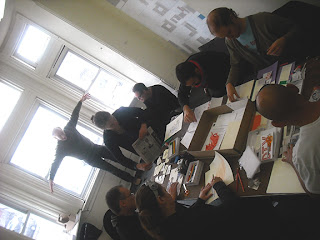On March 16th, my latest art project, the DIY Conceptual Artist, opened at DorisMae. Formerly Harmon Art Lab, the space is dedicated to a curatorial project run by Thomas Drymon... and he hesitates to call it a gallery.
The scope of the project is a game. As pictured above, it has a rule book, some art materials, and it comes in a box. Players can choose whether to execute one of several projects, and the projects are based on works by several archetypes of conceptual and contemporary art of the 20th Century.
Exhibiting one room over is Rachel England, who is showing the work she made for her senior thesis at the Corcoran, only with a twist. Instead of it being some inert installation, visitors are invited to destroy the work, pulling the crocheted scarves apart - skein-by-skein.
Creation in one room. Destruction in the other. All work is participatory.
On March 24th, the space was open for an artist talk. Only, we didn't talk. We just directed people through the act of participating with our projects. Pictured above are people diligently working on their pieces. More images on DoisMae's website.
This idea has had an odd life. Initially it was proposed to Transformer near the end of 2010. In a reply to the submission I was told that review of proposals sometimes takes a while. I guess the proposal is still under review. Then in late 2011, the curator from VisArts Rockville approached me about a 2012 exhibit. I introduced the idea, he liked it, the exhibit was scheduled, contracts were getting signed, and then someone higher up the food chain explained they no longer agreed with the curator's vision, released him from his contract, and along with it all of his exhibits (I guess he wasn't showing enough community plein air hobbyists, or something).
As with many of my projects, there are a bundle of ideas converging.
- After nearly a decade of teaching, I've had a lot of students resist contemporary art, and with it conceptual art. I wondered if there was a way to make the ideas and processes more accessible.
- Then there is the idea of traditions: old masters had apprentices, and sometimes the pieces of mature apprentices look nearly indistinguishable from the old master. At the very least you can see the relationship. Think early Raphael as compared to Perugino. 500 years ago, the practice of teh student looking similar to the master was more desirable. Now it is derivative. Anyone who drips paint on a canvas clearly echoes Pollock, and that's a bad thing, I guess, unless it's a slipcover for the couch.
- Additionally, I think Art should be affordable, everyone should make art (so, I don't really poo-poo the plein air painter), and everyone should have "original" art to display in their homes and offices (i.e. something made by had, not by machine). Clearly I don't think this should be everyone's living. I think it should be something they know how to do. That they shouldn't be limited to avenues of representation. That they should be open to a broad range of ideas, disciplines, and work. (I fully accept not all art made from my project will be good.)
- Of course there are some notions of subverting the function of the gallery space: Of making the gallery space interactive and collaborative: Of changing convention and expectations. Working with Mark Cameron Boyd opened me up to some of these ideas. And I can't ignore how popular the ideas has become to others, for example Reuben Breslars' Sketch (ironically, at Transformer), and Eames Armstrong's Smutty Valentine, artists leading artists in community art-making activities is nothing new. However, I (and I assume they also) don't want this to be limited to just artists.
- Finally, I've been wanting to write a book. I've been wanting to make a game. This project is a convergence of those two whims.
The game is selling for $30 ea. Half of all sales will go to the Tulk Family Education and Assistance Fund.






